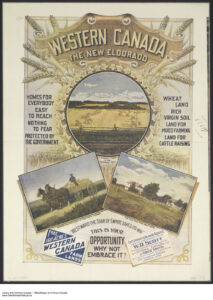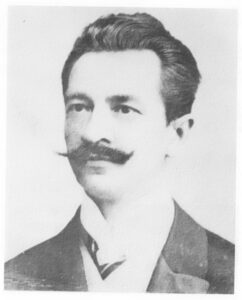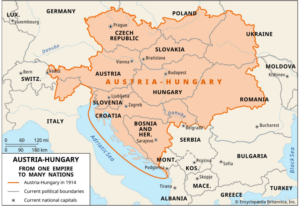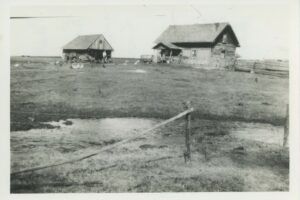Мазпа-Mazeba-Mazeppa

Ukrainians in Canada, Identity, and our Ukrainian Canadian House
In our collection of historic buildings Tipple Park Museum cares for a beautiful log house built by a family that began homesteading in the area in the early 1900s. Stefan and Helena, along with their children, made their way to Canada from what is now Ukraine in 1907 eventually settling in the Reno District just south of Evansburg. The log house that is in the museum’s collection today was built in 1911 and stood in its original location on the homestead until it was moved into Evansburg to be displayed by the Pembina Lobstick Historical Society. We do not have many photographs or interviews to tell us what life was like on the Mazeppa’s Ukrainian-Canadian homestead or to give us specific information about their early experiences in Canada.
The following is a short, general background on Ukrainian immigrants and some of the problems they experienced with their identity in a new land. The title “Мазпа-Mazeba-Mazeppa” refers to a common problem immigrants had, and have to this day, in navigating identity in the new world. Name changes can happen for a variety of reasons. We can view a paper trail of these changes for the Mazeppa, but cannot understand the impact, or all of the reasoning, behind it.
The Ukrainian Settlers
When Ukrainian immigrants first settled in Canada many held on to pieces of their traditional ways of life for some time. This can be seen in the way that many Ukrainian immigrants first set up their homesteads and the methods by which they built their first prairie homes. Many elected to build houses in the same style and layout as they would have used in Ukraine. Today some of these clay-plastered houses still stand east of Edmonton, and can be visited at the Ukrainian Cultural Heritage Village. Small details about these houses can remind us of the traditions of the people who first built them: the original orientation of the house, the layout commonly being two rooms, the clay plaster, thatched roofs, and perhaps a clay oven. These are all small clues about the identity of the people who lived in the house.
Ukrainians also brought their faith with them. Most Ukrainians belong to Eastern Rite churches (often Ukrainian Orthodox or Ukrainian Catholic churches). Eastern Rite churches very notably follow the Julian calendar, which means that major holidays such as Christmas or Easter are not celebrated at the same time as those who are more familiar with Western churches are used to. Many people on the prairies today are probably familiar with the Ukrainian tradition of decorating pysanky for Easter.
Ukrainians brought their traditional foods with them, some of which became extremely familiar to people living on the Canadian prairies. Cabbage rolls (holubsti), perogies (pyrohy/verenyky), and sausage (kovbasa) probably were among the most popular.
Ukrainians took advantage of the homesteading scheme offered by the Dominion Lands Act for a variety of political and socio-economic reasons. The homesteading scheme afforded opportunities for the Ukrainian settlers to have more farmland, to own their own farmland, and to live in a much different political climate. Many of the Ukrainians settled in Alberta are due to the work of one man, Dr. Josef Oleskiw. Oleskiw conducted extensive research to decide which of the countries offering a homesteading scheme was the most suitable. He wrote “Pro vilni zemli” encouraging Ukrainians to consider moving to Canada. He came to Canada himself to determine where the best land for farming was located. He greatly encouraged Ukrainian emigration and even hand-picked one of the first groups of settlers that arrived in Alberta. This first group settled at the Edna-Star colony east of Edmonton. Many communities east of Edmonton are part of a bloc settlement or an area that is settled by one ethnic group. The bloc settlement in Alberta, in broadly defined boundaries lies between Highways 28 and 16, and Highways 830 and 36.

Today Alberta has the most Ukrainians outside of Ukraine living here. Edmonton, and the area east of Edmonton, is full of Ukrainian culture to this day. Ukrainian bilingual schools operate, large Ukrainian dance schools can be found in the area, multiple festivals celebrating parts of Ukrainian culture are celebrated each year, and the Ukrainian Cultural Heritage Village displays early settler life.
Background: The Dominion Lands Act and Canada’s New Immigrants
The Dominion Lands Act of 1872 prescribed specific uses to the land of Western Canada, laying out regulations for how the land would be granted to settlers, colonization companies (companies that co-ordinate settlement and immigration), the HBC, railways, municipalities, and certain religious groups. It was modelled off of similar homesteading acts in the United States and South America. The Dominion Lands Act led to the largest land survey ever conducted as the Canadian prairies were divided into neat parcels of land. The homestead policies of the act encouraged settlement in the West. New immigrants from many European countries were encouraged to come and settle in Western Canada. In part, this act helped to prevent the west of Canada from being claimed by the United States.
The act came into being after Treaty 1 and 2 were signed. The signing of the treaties allowed Canada to annex indigenous land and act out plans to assimilate the indigenous people to a more Anglo-Canadian way of life and to settle the lands in the way the Government of Canada saw fit.
Identity in a New Land:
A Short Case Study

While many Ukrainians, and immigrants of all nationalities, preserved bits of their ethnic identity through the traditions that they continued to practice in their new home, identity was tricky for the first waves of European immigrants to the prairies.
If you have ever tried to do genealogical research into your own family you may have come up against frustrating and confusing walls when your surname seems to change, or your grandfather appears to have been born in a different country than you were led to believe.
These small mixups, and historical confusions, created a lot of problems for the first Ukrainians to settle in Canada. Some of these problems can clearly be seen if we look at the history of the family that the log house in our collection belongs to: The Mazeppas.
Problem: Ukraine does not exist yet, so who are the Ukrainians?
When the first waves of Ukrainians came to Canada they spoke Ukrainian, might have called themselves Ukrainian, followed Ukrainian traditions, and yet were seldom recorded as being “Ukrainian”. These immigrants can be found recorded as Russian, Carpathian, Russian Carpathian, or Austrian. Sometimes they were recorded using the specific traditional region they had come from: Galicia or Bukovina.
This is of course confusing to us today. It also created a complicated landscape for early Ukrainian Canadians to navigate their own identity through. Looking at documents from our own Mazeppa family we can witness this confusion.
Problem: The Austro-Hungarian Empire
These extreme identity confusions lead to many Ukrainian Canadians being sent to internment camps during the First World War. Having documents that listed them as “Austrian” meant that many Ukrainians were listed as enemy aliens at this time as Austria-Hungary was one of the Central Powers during the war. The Canadian First World War Internment Recognition Fund has an extensive list of resources if you are interested in learning more about this period in Canada’s history. Research has not indicated that members of the Mazeppa family were taken to internment camps
Problem: Language Mishaps
Many immigrants experienced name changes due to misunderstanding and misdocumentation. Ukrainians experienced a problem that many immigrants at the time experienced, and many experience to this day: Ukrainian does not not use the Latin alphabet like English does. Not only were Canadian officials transcribing names from another language, they were transcribing sounds from the Cyrillic alphabet into the English Latin alphabet. This can result in different spellings over time in just one family. For instance, resulting in something like: Мазпа-Mazeba-Mazeppa. This often also resulted in full name changes for some families, or the loss of traditional naming conventions once surnames were recorded using the Anglo-Canadian system in which all members of a family shared the same surname (as opposed to systems such as patronymic naming). Some of these language mishaps can be seen in the documents above as officials spelled the surname differently over the year
